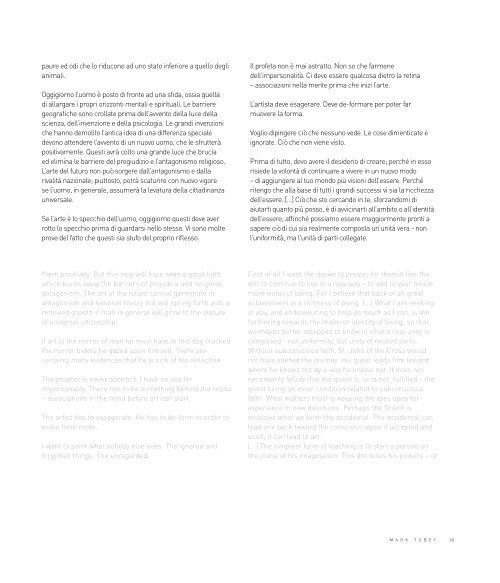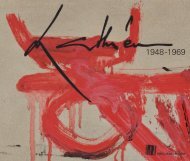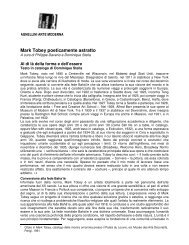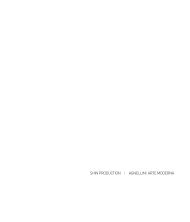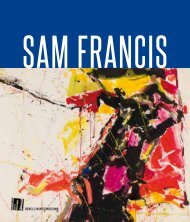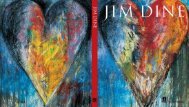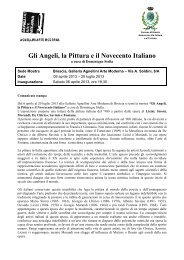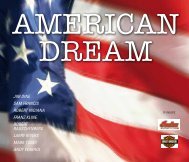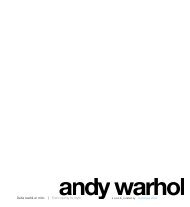Shin production | Agnellini Arte ModernA - Galleria Agnellini Arte ...
Shin production | Agnellini Arte ModernA - Galleria Agnellini Arte ...
Shin production | Agnellini Arte ModernA - Galleria Agnellini Arte ...
Create successful ePaper yourself
Turn your PDF publications into a flip-book with our unique Google optimized e-Paper software.
paure ed odi che lo riducono ad uno stato inferiore a quello degli<br />
animali.<br />
oggigiorno l’uomo è posto di fronte ad una sfida, ossia quella<br />
di allargare i propri orizzonti mentali e spirituali. le barriere<br />
geografiche sono crollate prima dell’avvento della luce della<br />
scienza, dell’invenzione e della psicologia. le grandi invenzioni<br />
che hanno demolito l’antica idea di una differenza speciale<br />
devono attendere l’avvento di un nuovo uomo, che le sfrutterà<br />
positivamente. Questi avrà colto una grande luce che brucia<br />
ed elimina le barriere del pregiudizio e l’antagonismo religioso.<br />
l’arte del futuro non può sorgere dall’antagonismo e dalla<br />
rivalità nazionale; piuttosto, potrà scaturire con nuovo vigore<br />
se l’uomo, in generale, assumerà la levatura della cittadinanza<br />
universale.<br />
Se l’arte è lo specchio dell’uomo, oggigiorno questi deve aver<br />
rotto lo specchio prima di guardarsi nello stesso. Vi sono molte<br />
prove del fatto che questi sia stufo del proprio riflesso.<br />
them positively. but this new will have seen a great light<br />
which burns away the barriers of prejudice and religious<br />
antagonism. the art of the future cannot germinate in<br />
antagonism and national rivalry but will spring forth with a<br />
renewed growth if man in general will grow to the stature<br />
of universal citizenship.<br />
if art is the mirror of man he must have in this day cracked<br />
the mirror before he gazed upon himself. there are<br />
certainly many evidences that he is sick of his reflection.<br />
the prophet is never abstract. i have no use for<br />
impersonality. there has to be something behind the retina<br />
– associations in the mind before art can start.<br />
the artist has to exaggerate. he has to de-form in order to<br />
make form move.<br />
i want to paint what nobody else sees. the ignored and<br />
forgotten things. the unregarded.<br />
il profeta non è mai astratto. non so che farmene<br />
dell’impersonalità. ci deve essere qualcosa dietro la retina<br />
– associazioni nella mente prima che inizi l’arte.<br />
l’artista deve esagerare. deve de-formare per poter far<br />
muovere la forma.<br />
Voglio dipingere ciò che nessuno vede. le cose dimenticate e<br />
ignorate. ciò che non viene visto.<br />
prima di tutto, devo avere il desiderio di creare; perché in esso<br />
risiede la volontà di continuare a vivere in un nuovo modo<br />
– di aggiungere al tuo mondo più visioni dell’essere. perché<br />
ritengo che alla base di tutti i grandi successi vi sia la ricchezza<br />
dell’essere. [...] ciò che sto cercando in te, sforzandomi di<br />
aiutarti quanto più posso, è di avvicinarti all’ambito o all’identità<br />
dell’essere; affinché possiamo essere maggiormente pronti a<br />
sapere ciò di cui sia realmente composta un’unità vera - non<br />
l’uniformità, ma l’unità di parti collegate.<br />
First of all i want the desire to create; for therein lies the<br />
will to continue to live in a new way – to add to your house<br />
more vistas of being. For i believe that back of all great<br />
achievement is a richness of being. [...] What i am seeking<br />
in you, and endeavouring to help as much as i can, is the<br />
furthering towards the realm or identity of being; so that<br />
we maybe better equipped to know of what a real unity is<br />
composed - not uniformity, but unity of related parts.<br />
Without subconscious faith, St. John of the cross would<br />
not have started the journey. his quest leads him toward<br />
where he knows not by a way he knows not. it does not<br />
necessarily follow that the quest is, or is not, fulfilled - the<br />
quest being an inner condition related to subconscious<br />
faith. What matters most is keeping the eyes open for<br />
experience in new directions. perhaps the orient is<br />
inclusive what we term the accidental. the accidental can<br />
lead one back toward the conscious again if accepted and<br />
used; it can lead to art.<br />
[...] the simplest form of teaching is to start a person on<br />
the plane of his imagination. this discloses his powers – or<br />
m a r k t o b e y 60<br />
Senza una sua fede subconscia, San giovanni della croce non<br />
avrebbe mai iniziato il proprio viaggio. la sua ricerca lo ha<br />
condotto ove lui non sapeva, tramite una via a lui sconosciuta.<br />
ciò non significa che la ricerca venga o non venga realizzata<br />
– poiché la ricerca è una condizione interna legata alla fede<br />
subconscia. ciò che conta maggiormente è tenere gli occhi<br />
aperti all’esperienza in nuovi settori. Forse l’oriente comprende<br />
ciò che definiamo “fortuito”. il “fortuito” può riportarci indietro<br />
verso la coscienza qualora questa venga accettata ed utilizzata;<br />
ci può condurre verso l’arte.<br />
lack of powers - of observation. his consciousness or lack<br />
stimulates his observation, which in turn stimulates his<br />
retentive memory, and unites with imagination in the next<br />
attempt. this approach to teaching would appear very slow<br />
but it is a much truer path than the recipe methods taught<br />
by lazy teachers.<br />
(note tratte da_notes selected from: Arthur l. dahl (ed.), Mark tobey.<br />
Art and belief, george ronald, oxford, 1984; Mark tobey. Works on<br />
paper from northern california and Seattle collections. celebrating<br />
the centenary of the artist’s birth, Stanford university Museum of Art,<br />
Stanford Art gallery, 1990; Mark tobey. paintings from the collection<br />
of Joyce and Arthur dahl, Stanford university, Stanford Art gallery,<br />
1967/68; William c. Seitz, Mark tobey, the Museum of Modern Art, new<br />
york, 1962; Mark tobey. paintings 1920-1960, yoshii gallery, new york<br />
1994; eliza rathbone, Mark tobey. city paintings, national gallery of<br />
61 m a r k t o b e y<br />
[...] la forma più semplice di insegnamento consiste nell’iniziare<br />
una persona al livello della sua immaginazione. ciò rivela le<br />
sue capacità – o incapacità di osservazione. la sua coscienza<br />
o la mancanza della stessa stimola la sua osservazione, che<br />
a sua volta stimola la sua ottima memoria, associandola<br />
all’immaginazione al tentativo successivo. tale approccio<br />
all’insegnamento sembra essere molto lento, ma in realtà è un<br />
percorso molto più vero rispetto ai metodi standard insegnati<br />
oggigiorno da pigri docenti.<br />
Art, Washington, 1984; northwest traditions, Seattle Art Museum, 1978;<br />
Mark tobey. tempera, gouaches, Aquarelle, Zeichnungen, erker-galerie,<br />
St. gallen, 1986/87; Mark tobey. between worlds. opere 1935-1975,<br />
Museo d’<strong>Arte</strong> Mendrisio/Museum Folkwang, essen, 1989; tobey’s 80.<br />
A retrospective, Seattle Art Museum, 1970; tobey. exhibition on the<br />
occasion of his 80th birthday, galerie beyeler, basel, 1970/71; Mark<br />
tobey, editions beyeler, basel, 1971; Mark tobey, the dot and the circle,<br />
in World order, A bahà’ì Magazine, Wilmette/ill., Spring, 1977; colette<br />
roberts, Mark tobey, grove press inc., new york, 1959).


